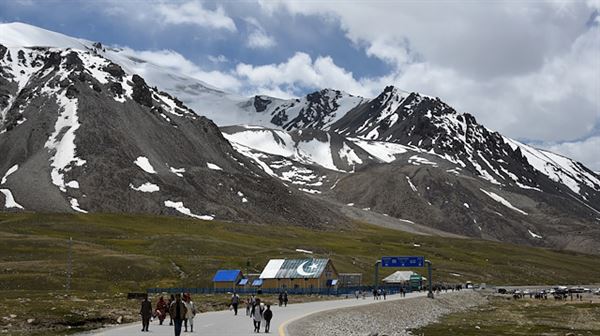Pakistan is often seen through the prism of terrorism and security, but it is undoubtedly one of a handful countries that offer a unique blend of hist
Pakistan is often seen through the prism of terrorism and security, but it is undoubtedly one of a handful countries that offer a unique blend of history and biodiversity to the eco-lovers.
From the snow-capped peaks in the north, and glistening waters in the south together with limitless opportunities to watch wildlife, sail in the mighty Indus river, and deep-sea diving in the Arabian Sea, this South Asian nuclear state has much more to attract the eco-lovers.
Northern Gilgit-Baltistan region, which borders neighboring China, is home to the six peaks of over 8,000-meter altitude, including the world’s second tallest peak, K-2.
In addition to that, the region has over 5,000 large and small glaciers and more than 100 lakes, which jointly make up the world’s largest freshwater reservoir.
Also, the eco-lovers can witness the endangered snow leopard and brown bear, in addition to 300 species of wildlife in the breathtaking region.
One can sail in the Indus to witness blind dolphins — also known as Indus dolphins.
Locally known as “Bhulan” and only found in the River Indus — mainly in a 1,300-kilometer (807-mile) long stretch between northeastern and southern Pakistan — the mammal is blind because it does not have a crystal eye lens.
Towards the mountains such as in Khunjerab National Park in Gilgit-Baltistan, there are guaranteed sightings of the Himalayan Ibex and if one travels to northwestern Chitral near Afghanistan border, then markhor — the country’s national animal.
There are opportunities to watch wildlife, marine turtles nesting near southern port city of Karachi together with very approachable Kirthar and Hingol National Parks in southern Sindh and southwestern Balochistan provinces, offering a mix of both history and biodiversity.
But, according to local experts, the country has failed to exploit the huge potential of its unique biodiversity, due to multiple reasons, mainly security concerns, lack of facilities, and capacity building.
“Pakistan is a very unique country with countless ecotourism attractions. It has mountain ranges with exceptional terrain, wetlands and numerous opportunities such as skiing, paragliding, and deep sea diving,” Uzma Khan, a Lahore-based expert who regularly writes on environment and wildlife, told Anadolu Agency.
However, she observed the security concerns compounded by inability to profile the country’s eco-richness had kept the international tourists away from Pakistan.
– Barriers
Asma Ezdi, who works for Pakistan chapter of the World Wide Fund for Nature, cited lack of an integrated approach to tourism planning and investment, lack of capacity among public and private stakeholders, and insufficient promotion of sustainable products and services at tourist destinations, as major barriers in promotion of ecotourism in Pakistan.
Also, she added, absence of monitoring and evaluation system for tourism was another key reasons behind Islamabad’s failure to market its rare biodiversity.
“These barriers and unchecked population growth have led to various issues, such as environmental degradation, lack of solid and water waste management, inefficient resource use, non-renewable energy sources and ill-planned development, at tourist destinations”, she told Anadolu Agency.
Rana Aftab, a member of the recently formed National Tourism Coordination Board (NTCB), a state-run entity, voiced a similar view.
He cited lack of planning for the government’s part, lack of capacity building and inter-departmental cooperation as other reasons behind a static growth in eco-tourism.
“Eco-tourism is a specialized field. It requires lesser investment compared to other fields of tourism, but an active community involvement,” said Aftab, who is head of the NTCB’s ecotourism committee.
Sustainable Tourism Foundation Pakistan — a non-governmental organization that works for promotion of eco-tourism in the country — last year launched an ecotourism project for conservation of Indus Dolphins. The organization has also trained local fishermen to arrange river ride for tourists to witness blind dolphins.
In addition, it is also working on two other projects for conservation of the centuries-old culture of Kalasha valley in Chitral district, and near-extinct snow leopard in Hoper valley of Gilgit-Baltistan. Eventually, the two sites, Aftab said, would be declared as eco-tourist destinations.
– Slight improvement
Uzma Khan reckoned that the country’s otherwise dwindling eco-tourism had shown some improving signs in recent years.
“I think it is on the track as there is a lot of focus on improving facilities and profiling tourism to attract foreign and local tourists,” Khan opined.
“Media and foreign tourists are playing a positive role is profiling Pakistan’s eco-tourism”, she said, referring to several foreign tourists’ who have written blogs and posted videos on social media of Pakistan’s scenic tourists destinations in recent months.
Khan termed a significant improvement in security a key factor that attracted foreign travel bloggers and vloggers to visit Pakistan in recent months.
“But a lot still needs to be done to make Pakistan’s tourism up to the mark”, she went on to say.
Aftab partially agrees with Khan, opining “Ecotourism is in an infancy stage in Pakistan. But we have a great potential to emerge as an ecotourism nation within next three to four years, if seriousness is shown”.
He said the NTCB’s ecotourism committee had identified over 100 sites across the country, which would be developed as tourism destination in coming years with the help of local communities who would avail the economic benefit of eco-tourism in their respective areas.
Out of 100, Aftab added, 30 sites could immediately be turned into ecotourism hotspots.
